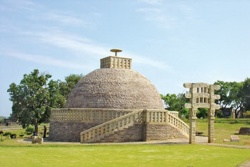Chaitya
Another excavated cave about a hundred years later is the magnificent Prayer hall or Chaitya, at Karle in the Poona district. This too has been excavated from the living rock and is unparalleled for its lofty and elevated impression.
The size is truly stupendous, 124'x46-1/2'x45'. With well proportioned great and bulky pillars, carrying capitals of great originality holding up a vaulted roof that has real rafters of timber inserted into it, a ribbing inherited and copied from wooden structure.
The columns are strong and bulky, surmounted by sculptured capitals.
In the far distance there is a Stupa with a wooden umbrella on top and astonishingly the original wood has survived unharmed to this date.The Buddhist Stupa is another Form of architecture, comprising a hemispherical dome, a solid structure into which one cannot enter.
The Stupa is a glorified, beautified, enlarged funerary mound: what was once the resting place of the bones and ashes of a holy man.
Tradition has it that after the great demise of Lord Buddha,
Emperor Ashoka decided to construct a large number of Stupas throughout his dominion in memory of the Master and enshrine in them Relics such as pieces of bones, teeth, Hair etc., over which the Stupas were constructed.
Originally the Stupa was made of bricks and surrounded by a wooden railing.
The existing Stupa at Sanchi encloses the original Stupa and has been enlarged and enclosed within the stone railing or balustrade, when stone was adopted in the place of wood.
To the Stupa which consisted of a domical structure, a base, sometimes circular, sometimes square, was added in the 1st century B.C., a circumambulatory Path as well as the stone railing with four elegantly carved gateways in the four cardinal Directions.
In place of the original wooden umbrella, which was put up to signify the Stupa represented and was built over the ashes of the Lord or his immediate disciples, a sign of royalty and dignity,
developed in the course of Time an Interesting composition on top of the dome, the Harmika;
a square Buddhist railing from which rises the shaft that holds the imperial umbrella, sometimes single and later on multiplied to three or even more, diminishing in size as they go upwards.
The railing and gateways at Bharhut, Sanchi and Bodh Gaya are the most famous in the north and at Amravati and Nagarjunakonda in the South.
Upright pillars and cross bars, based on wooden construction, were made and provided the occasion for dome of the finest low relief carvings to be found anywhere in Indian Art.
On these surfaces are carved the favourite Symbols of Buddhism,
the Lotus, elephant, bull, lion and Horse and some of the Jataka stories of the previous births of Buddha, depicted in low relief with such exuberant details that they are considered a land-mark in the story of Indian Art.
The Sanchi Stupa has a diameter of 120' and a height of 54'. About these gateways one thing stands that most of early Indian architecture was of wood and timber and that these are true imitations in stone of early wooden construction.
